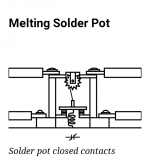Oh btw, make sure nobody did away with the relief valve, and if the one that is there pops off below the working pressure of the tank. It will be made of brass and have a number stamped on it. It will look something like thisView attachment 2565945
There is also an adjustable type, You probably want it to pop off at like 185 if you are setting the high limit on the pressure switch to 175
The relief valve is usually based on the ASME rating of the pressure tank (presuming there’s a tank). It could be possible to raise the pressure control and overload the motor without popping the relief valve.
Field-adjustable safety relief valves are not allowed any more. If it’s the adjustable type, it will have a wire and lead seal to make it evident if it was tampered with.
If somebody removed the relief valve, they should be hanged, drawn, and quartered!










